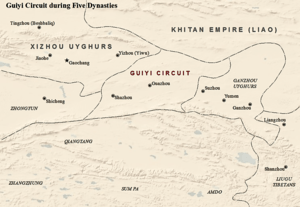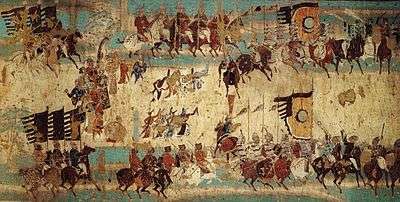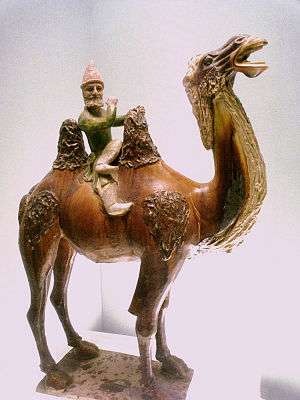Guiyi Circuit
| Guiyi Circuit/Guiyi Army/Xihan Jinshan Guo | |||||||||||
|---|---|---|---|---|---|---|---|---|---|---|---|
| 851–1036 | |||||||||||
 | |||||||||||
| Status | Circuit/Kingdom/Tributary to Tang Dynasty | ||||||||||
| Capital |
Ganzhou (Zhangye) Shazhou (Dunhuang) | ||||||||||
| Common languages | Chinese, Old Tibetan, Sogdian | ||||||||||
| Government | Monarchy, Military | ||||||||||
| History | |||||||||||
• Established | 851 | ||||||||||
• Disestablished | 1036 | ||||||||||
| |||||||||||

The Guiyi Circuit, also known as the Guiyi Army (Chinese: 歸義軍; pinyin: Guīyìjūn; Wade–Giles: Kui1-i4-chün1; literally: "Return to Righteousness Army", 848–1036 AD), was a regional regime nominally subordinate to the Chinese Tang dynasty and later on the Northern Song dynasty. The Guiyi Circuit was controlled by the Zhang family from the second half of the 8th century to the 10th century and then the Cao family until the 11th century. The Guiyi Circuit was headquartered in Shazhou Prefecture (沙州) (modern Dunhuang).
Background

The Hexi Corridor was an important part of the Silk Road, connecting Central Asia with Northwest China. After the An Lushan Rebellion, the Hexi Corridor was occupied by the Tibetan Empire.[1] Around the 770s or the 780s, Shazhou Prefecture, otherwise known as Dunhuang, was occupied by the Tibetans.[2]
Zhang family
After some 60 years of Tibetan rule, Tibet entered its Era of Fragmentation and was torn by civil war by 851.
In 848 Zhang Yichao, a resident of Shazhou Prefecture, led an uprising and captured Shazhou and Guazhou prefectures from the Tibetans.
By 850 Zhang had captured Ganzhou, Suzhou, and Yizhou prefectures.[3] Zhang claimed the title of acting prefect of Shazhou and submitted a petition to Emperor Xuānzong of Tang, offering his loyalty and submission.
In 851 Zhang captured Xizhou Prefecture (Gaochang). Envoys from Shazhou prefecture reached the Tang court and the emperor responded by who naming Zhang's territory the Guiyi Circuit and made Zhang Yichao the Guiyi Jiedushi (歸義節度使, Governor of the Guiyi Circuit) and Cao Yijin his secretary general.
By 861 the Guiyi Circuit had extended its authority to Guazhou, Ganzhou, Suzhou, Yizhou, Lanzhou, Shanzhou, Hezhou, Minzhou, Liangzhou, and Kuozhou prefectures.
In 866 Zhang Yichao defeated the Tibetan general Baönhrom Barhé and seized Luntai (Ürümqi) and Tingzhou Prefecture. However they were immediately captured by the Kingdom of Qocho afterwards. Xizhou Prefecture (Gaochang) was also captured by the Uyghurs.
In 867 Zhang Yichao departed for the Tang court after his brother Yitan died. His nephew Zhang Huaishen succeeded him as Guiyi Jiedushi.
In 869 the Kingdom of Qocho (Xizhou Uyghurs) attacked the Guiyi Circuit but was repelled.
In 870 the Kingdom of Qocho attacked the Guiyi Circuit but was repelled.
In 872 Zhang Yichao died at court.
In 876 the Kingdom of Qocho seized Yizhou Prefecture.
Around the years 881 and 882, Gan and Liang prefectures slipped from the control of the Guiyi Circuit. The Ganzhou Uyghur Kingdom would establish itself in Ganzhou Prefecture by 894. In Liang prefecture the Tibetan state of Xiliangfu established itself by 906.
In 890 Zhang Huaishen was assassinated and his cousin Zhang Huaiding succeeded him.
In 892 Zhang Huaiding died and left his son in the care of Suo Xun (索勳), son-in-law of Zhang Yichao. Suo Xun declared himself Guiyi Jiedushi.
In 894 Suo Xun was killed by a local aristocrat by the name of Li Mingzhen and Zhang Yichao's daughter. Li's sons shared control of Guiyi Circuit afterwards.
In 896 Li Mingzhen's sons were ousted and Zhang Chengfeng (張承奉), a grandson of Zhang Yichao, became jiedushi.
In 910 Zhang Chengfeng received news of the Tang dynasty's demise and declared himself Emperor Baiyi. The Guiyi Circuit was renamed Kingdom of Jinshan.
Kingdom of Jinshan
In 910 Zhang Chengfeng established a kingdom known as the Xihan Jinshan (西漢金山國 Xīhàn Jīnshānguó), "The Golden Mountain Kingdom of the Western Han," and gave himself the title of "Son of Heaven."[4][5] This was followed by an invasion by the Ganzhou Uyghurs.
In 911 the Ganzhou Uyghurs attacked again and the Kingdom of Jinshan was forced to become a lesser partner in an alliance with the Ganzhou Uyghurs. The Great Chancellor (大宰相) and the elders of Jinshan State made a treaty with the Ganzhou Uyghurs, recognizing their superiority. The relationship between the two was prescribed as
"...the Khan is the father, and the Son of Heaven is the son..." (...可汗是父,天子是子...)[4]
In 914 Cao Yijin usurped the throne and abolished the kingdom, reverting the name to Guiyi Army.
Cao family

In 914 Cao Yijin (曹議金) usurped the throne and restored the Guiyi Circuit.
In 916 Cao Yijin married a Ganzhou Uyghur princess and sent delegations to the Later Liang.
In 924 the Ganzhou Uyghur Khagan died and his successors Renmei and Diyin declared war on each other, with Diyin coming out victorious.
In 925 Cao Yijin defeated the Ganzhou Uyghurs.
In 926, Diyin died, and Aduoyu (阿咄欲) became the Khan of the Ganzhou Uyghurs. Aduoyu married a daughter of Cao Yijin.
Kingdom of Guiyi
In 931 Cao Yijin declared Guiyi a kingdom.
In 934 Cao Yijin married his daughter to the king of Khotan.
In 935 Cao Yijin died and his son Yuande succeeded him.
In 939 Cao Yuande (曹元德) died and was succeeded by his brother Yuanshen (曹元深).
In 944 Cao Yuanshen died and his brother Yuanzhong (曹元忠) succeeded him. Cao Yuanzhong's reign was characterized by progress in agriculture, transportation, and printing.[6] Relationship with the Ganzhou Uyghurs remained relatively stable during this period.[7]
In 950 the first depiction of fire lances appeared in Shazhou Prefecture.
In 974 Cao Yuanzhong died and his nephew Cao Yangong (曹延恭) succeeded him.
In 976 Cao Yangong died and his brother Yanlu (曹延祿) succeeded him.
In 1002 Cao Yanlu's nephew Cao Zongshou rebelled in Shazhou Prefecture. Cao Yanlu and his brother Cao Yanrui (曹延瑞) committed suicide. Cao Zongshou became ruler of Guiyi.[8][9]
In 1014 Cao Zongshou died and his son Cao Xianshun (曹賢順) succeeded him.
In 1028 the Tanguts defeated the Ganzhou Uyghurs.[10]
In 1030 Cao Xianshun surrenderred to the Tanguts.[10]
In 1036 the Tanguts, who later established the Western Xia, annexed the Kingdom of Guiyi.[10]
Sogdians of Dunhuang

During the Tang and subsequent Five Dynasties and Song Dynasty, large communities of Sogdians lived in China, especially in the multicultural entrepôt of Dunhuang, Gansu, a major center of Buddhist learning and home to the Buddhist Mogao Caves.[11] While the region occasionally fell under the rule of different states (the Tang, the Tibetan Empire, and later the Western Xia led by the Tanguts), it retained its multilingual nature as evidenced by an abundance of manuscripts (religious and secular) in Chinese and Tibetan, but also Sogdian, Khotanese (another Eastern Iranian language native to the region), Uyghur, and Sanskrit.[12]
From the Chinese surnames listed in the Tang-era Dunhuang manuscript Pelliot chinois 3319V (containing the following text: 石定信右全石丑子石定奴福延福全保昌張丑子李千子李定信), the names of the Nine Zhaowu Clans (昭武九姓), the prominent ethnic Sogdian families of China, have been deduced.[13] Of these the most common Sogdian surname throughout China was Shi (i.e. 石), whereas the surnames Shi (i.e. 史), An, Mi (i.e. 米), Kang, Cao, and He appear frequently in Dunhuang manuscripts and registers.[14] The influence of Sinicized and multilingual Sogdians during this Guiyijun (歸義軍) period (c. 850 - c. 1000 AD) of Dunhuang is evident in a large number of manuscripts written in Chinese characters from left to right instead of vertically, mirroring the direction of how the Sogdian alphabet is read.[15] Sogdians of Dunhuang also commonly formed and joined lay associations among their local communities, convening at Sogdian-owned taverns in scheduled meetings mentioned in their epistolary letters.[16]
See also
References
- ↑ "补唐书张议潮传" by 罗振玉
- ↑ "吐蕃和平占領沙州城的宗教因素" by 張延清
- ↑ Rong 2013, p. 40.
- 1 2 "归义军史研究——唐宋时代敦煌历史考索" by 荣新江
- ↑ "羅叔言《補唐書張議潮傳》補正" by 向達
- ↑ "中国古代印刷史" by 罗树宝
- ↑ "敦煌历史上的曹元忠时代" by 荣新江
- ↑ "宋会要辑稿" by 徐松
- ↑ "续资治通鉴长编" by 李焘
- 1 2 3 "西夏紀" by 戴锡章
- ↑ Galambos, Imre (2015), "She Association Circulars from Dunhuang", in Antje Richter, A History of Chinese Letters and Epistolary Culture, Brill: Leiden, Boston, pp 870-71.
- ↑ Galambos, Imre (2015), "She Association Circulars from Dunhuang", in Antje Richter, A History of Chinese Letters and Epistolary Culture, Brill: Leiden, Boston, p 871.
- ↑ Galambos, Imre (2015), "She Association Circulars from Dunhuang", in Antje Richter, A History of Chinese Letters and Epistolary Culture, Brill: Leiden, Boston, pp 871-72.
- ↑ Galambos, Imre (2015), "She Association Circulars from Dunhuang", in Antje Richter, A History of Chinese Letters and Epistolary Culture, Brill: Leiden, Boston, p. 872.
- ↑ Galambos, Imre (2015), "She Association Circulars from Dunhuang", in Antje Richter, A History of Chinese Letters and Epistolary Culture, Brill: Leiden, Boston, pp 870, 873.
- ↑ Galambos, Imre (2015), "She Association Circulars from Dunhuang", in Antje Richter, A History of Chinese Letters and Epistolary Culture, Brill: Leiden, Boston, pp 872-73.
Bibliography
- Asimov, M.S. (1998), History of civilizations of Central Asia Volume IV The age of achievement: A.D. 750 to the end of the fifteenth century Part One The historical, social and economic setting, UNESCO Publishing
- Barfield, Thomas (1989), The Perilous Frontier: Nomadic Empires and China, Basil Blackwell
- Benson, Linda (1998), China's last Nomads: the history and culture of China's Kazaks, M.E. Sharpe
- Biran, Michal (2005), The Empire of the Qara Khitai in Eurasian History: Between China and the Islamic World, Cambridge University Press
- Bregel, Yuri (2003), An Historical Atlas of Central Asia, Brill
- Bosworth, Clifford Edmund (2000), The Age of Achievement: A.D. 750 to the End of the Fifteenth Century - Vol. 4, Part II : The Achievements (History of Civilizations of Central Asia), UNESCO Publishing
- Bughra, Imin (1983), The history of East Turkestan, Istanbul: Istanbul publications
- Drompp, Michael Robert (2005), Tang China And The Collapse Of The Uighur Empire: A Documentary History, Brill
- Golden, Peter B. (2011), Central Asia in World History, Oxford University Press
- Hansen, Valerie (2015), The Silk Road: A New History, Oxford University Press
- Haywood, John (1998), Historical Atlas of the Medieval World, AD 600-1492, Barnes & Noble
- Latourette, Kenneth Scott (1964), The Chinese, their history and culture, Volumes 1-2, Macmillan
- Mackerras, Colin (1990), "Chapter 12 - The Uighurs", in Sinor, Denis, The Cambridge History of Early Inner Asia, Cambridge University Press, pp. 317–342, ISBN 9780521243049
- Millward, James A. (2007), Eurasian Crossroads: A History of Xinjiang, Columbia University Press
- Mackerras, Colin, The Uighur Empire: According to the T'ang Dynastic Histories, A Study in Sino-Uighur Relations, 744-840. Publisher: Australian National University Press, 1972. 226 pages, ISBN 0-7081-0457-6
- Rong, Xinjiang (2013), Eighteen Lectures on Dunhuang, Brill
- Sinor, Denis (1990), The Cambridge History of Early Inner Asia, Cambridge University Press, ISBN 978-0-521-24304-9
- Wang, Zhenping (2013), Tang China in Multi-Polar Asia: A History of Diplomacy and War, University of Hawaii Press
- Xiong, Victor (2008), Historical Dictionary of Medieval China, United States of America: Scarecrow Press, Inc., ISBN 0810860538
- Xue, Zongzheng (1992), Turkic peoples, 中国社会科学出版社